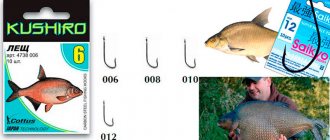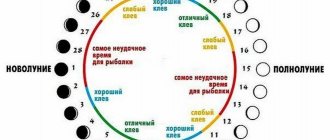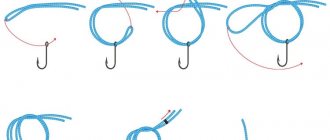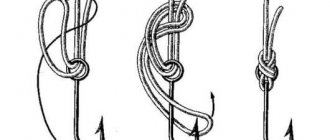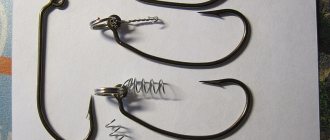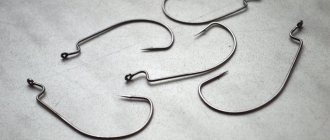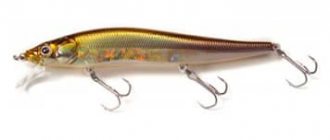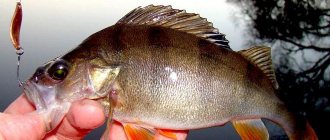A fishing hook is precisely that distinctive attribute without which no fishing can be done. Every fisherman, without exception, is familiar with this important and fundamental element of equipment. But most beginners in such an interesting activity as fishing do not always understand their first steps in choosing the right accessory for fishing conditions.
Most likely, difficulties arise due to differences in the designations of the goods offered at retail outlets. After all, numerous manufacturers mark the sizes of fishing hooks using methods that differ from each other, and in literary and other information sources the material supplied does not always correctly reflect the essence of a competent selection, giving out numbering for one common comb, which misleads the inexperienced fisherman.
This article will help you understand the differences in the classification of hooks and understand the essence of the design features of this component of the equipment, and the most famous manufacturers producing fishing hooks will be presented to the reader’s attention.
What are the classifications of hooks?
One of the primary selection criteria is the size of the fishing hook. It is this parameter of the product that plays an important role in catching fish of a certain size. The selected size of the accessory should allow you to securely attach the required volume of bait, which the fish can swallow without much effort. Many fishermen are surprised by the fact that on the store counter he notices a product designated by the same number, but visually differing in dimensions several times.
This is precisely the case when the hook numbers are designated according to classifications that differ radically in the methodology for determining the size. It just so happens that today we most often come across several main types of markings, the nuances of their formation will be discussed in our further and more detailed discussion.
Domestic
Our domestic classification of hooks is logical and easy to understand. Without any kind of unnecessary calculations and guesswork, using just the numerical value of the accessory, you can easily figure out the size of the hook. In addition, the numbering scale is built on an ascending principle: the higher the number, the larger the product, which is more understandable when selecting the right option for fishing conditions. The numerical value according to the domestic classification method is assigned based on the distance measured from the forearm to the sting, and this, simply put, is the usual width of the hook.
Important! The model range in the domestic line of accessories begins with the numerical value 2 and ends with the largest number, and therefore the product numbered 16.
To determine the hook number, a simple measurement is enough. But it is worth noting that this technique is not popular in the international fishing sphere and its application is mainly used in our country and neighboring countries of the post-Soviet space.
International
Most European and American well-known brands producing fishing hooks operate according to the international classification. To be fair, we add that the so-called international numbering system is actually a purely English method for calculating sizes, often called the Reddish scale. The system received this name from the British city of Redditch, where a famous factory for the production of fishing accessories was located. The classification developed by the plant's management has taken root in the fishing industry, becoming the world's main system for designating the size range of a fishing hook. The classification of fishing hooks on the international scale is radically different from the domestic system.
Important! In the international classification, the largest numerical value corresponds to the size of the smallest hook.
The line of sizes itself fits into the numerical range from 24 to 1. As a result of design changes in the accessory and the need for the production of larger products, the numbering has undergone changes and hooks whose dimensions exceed the classic original limit, most often this applies to offset workers, are designated by a double number according to the presented further example - 2/0. There is no logical explanation for the reverse numbering and you simply have to remember it, sometimes comparing it with a more understandable domestic size classification scale.
Japanese
Japanese manufacturers present the product according to their own classification scale. Without further ado and without bothering to invent a diagram, they adopted as a basis the principle of calculating size according to the international system, with the difference that the Japanese size range was shifted upward by two points. Thus, it turns out that the tenth hook size on the international scale corresponds to the size of the twelfth number according to the Japanese classification, and the English twentieth corresponds to the twenty-second Japanese number. Based on this fact, when purchasing fishing hooks, you should definitely pay attention to the country of origin of the product and only after that analyze the sizes of fishing hooks by numbering corresponding to the origin of the product.
Finnish
The Finnish system makes it even more difficult to determine the appropriate numerical value. In some ways, the Finnish version of numbering is similar to the Japanese scale, but it has a number of important differences that the fisherman needs to know when choosing the optimal size product. This classification lacks a number of dimensions inherent in other systems, and the bottom of the assembled table, where the largest hooks are assigned, is designated by two numbers, like the modern superstructure of the international system.
In addition to these nuances, fishing hooks numbers 14, 16, 18 and 22 coincide with Japanese accessories, taking into account the decrease in their value by one. It cannot be denied that there is a certain complexity in comparing products in this area, but with accumulated knowledge and updating of various systems, literacy and accuracy in selecting the right hook can be achieved by the fisherman, regardless of the country of manufacture.
Methods of knitting to fishing line
In fishing stores you can find ready-made, already assembled gear for summer or winter fishing, and you don’t have to tie a fishing hook yourself. But during fishing, a hook occurred and it was lost. While tying it is not difficult for amateurs and professionals, a beginner is unlikely to know how to tie knots, but for an angler, knowing how to tie it is a necessity.
Therefore, below are several ways to properly tie a hook:
- Fisherman's Eight
. Figure 8 fisherman's knots are very strong and are one of the most popular ways to crochet. - Shtykova
. This knitting is the simplest. It cannot be used for synthetic cord, as the line may break under strong tension. - Stepped
. Step knots are necessary for forged hooks, which usually lack an eye. This method is also used for winter fishing, so that the bait plays more naturally in the water column. If there is an eye, then it is better to tie the fishing line in a different way. - Eight Canadian
. Figure 8 knots are ideal if you are using synthetic line. If the hook needs to be removed, the knot can be easily untied and re-tied. - Turtle knots
are good for cotton cord, but if you tie synthetic fishing line using this method, it may break. - Blind knots
are one of the simplest and most reliable methods of fastening, which is used when the leash has a loop that does not tighten. You can tie a sinker in the same way. - The shark knot
is difficult to perform. Its knitting requires skill, however, it guarantees reliable fastening. Suitable for synthetics only. - Californian knots
are usually tied only for nylon fishing line. This is a simple, but at the same time very reliable mount. - The salmon knot
is simple and reliable. They can be used to attach a hook to any type of cord. - A catch knot
is a half knot that is made to tie one end of a synthetic line to the other. - The tuna knitting method
is used for synthetics. Perhaps tying a hook with such a knot means providing the strongest fastening for a synthetic cord.
We invite you to watch a video on how to properly sharpen a hook.
To keep the sharpness longer, after fishing, put a cap made of a piece of insulation on the tip or wrap the hook in the elastic band of the rod.
Sizes and table of fishing hooks
It’s quite easy to compare hook sizes by having a comparison table in front of your eyes. This kind of hint will be a useful help not only to a novice fisherman, but also to a wise, experienced fisherman. You can print the table or simply download it to your gadget and, if you need to select one, quickly decide on the hook option that is suitable for the angler to purchase and make fishing easier. We have summarized the most well-known classifications in the table, and in particular, the international, Russian, Finnish and Japanese schemes, according to the numbering of which our domestic market offers fishing products.
How to choose fishing hooks
In addition to the number value that characterizes a fishing hook by size, this important element of equipment has a couple more significant parameters that affect the quality and success of fishing. After all, the choice of hook is not only based on the type of bait used and the size of the fish planned to be caught. It is for these parameters that hooks are selected according to size, shape and material from which the accessory is made. The hook included in the installation should not make the tackle rough and alarming to the trophy. The color and thickness of the material are responsible for these conditions. And for the reliability of the hook and the final positive result in the form of a catch, responsibility falls on the sharpness of the hook tip.
Size
We have already talked about the features of choosing the sizes of fishing hooks by numbers, citing options for marking systems and providing the angler with a specific comparative table. All that remains is to indicate that upon purchase, the product number marking is applied to the product packaging. The fisherman will not have to look for the product number for a long time; the number will be clearly visible on the front side of the package. The Roman numerals of the marking will indicate the type of hem of the forend and the principle on which the mounting eye is designed - with a spatula or a ring. The extreme digital value of the marking indicates the length of the forend.
Material
As a rule, regardless of the number of fishing hooks, they are made of high-quality steel, endowed with certain properties during heat treatment.
Important! The hook should be equally elastic and at the same time quite durable.
Checking the properties of a material is quite simple. When purchasing a product, you can subject it to load by bending the sting away from the fore-end. Soft hooks, and this indicates a low quality product, will easily unbend without returning to their original shape. An overly rigid hook, and this is a factor of improperly hardened steel, will break at the slightest excessive deformation. A reliable product springs back when bent, returning to its original state after applying a test load. Soft or excessively hard hooks can be re-heat treated by hardening, for soft types, or by tempering the steel, thus reducing the hardness.
Form
There are three main forms of fish hook. The most common and well-known type is single. This variety is used in float and bottom fishing for both peaceful and predatory fish, and the number of the fishing hook determines the overall parameters of the accessory. Double krchoyuk is most often used when catching predatory fish with live bait. This form is a tandem of single hooks on one wire base, bent into a loop-shaped eye with the tip of the product spread 120 degrees. Doubles may differ in an asymmetrical forend, with different levels of spreading stings.
Tees are used to equip most types of artificial baits, spinners and wobblers. As well as doubles for live bait fishing. A triple hook is assembled from single specimens of equal size, soldering their shanks into one structure ending with a fastening ring. The tips of this design are each separated from each other by 120 degrees, as already mentioned in the discussion of the design of the double.
Color
Fishing hooks have a fairly wide range of colors. Most often, the steel is usually painted by the manufacturer in a certain color, but sometimes the color background is created by anti-corrosion coatings. Absolutely any numbering of fishing hooks can have a completely different color tone, selected by the fisherman depending on the fishing conditions.
Important! As a rule, the color of the selected accessory will depend on the color of the bait used.
On sale you can find silver and golden hooks used in float and bottom fishing. Brown, black and blue hooks are more suitable for catching predators with live bait. Red or green colors are suitable for fishing, where all kinds of larvae and insects are used as bait.
Thickness
Determining the size of a fishing hook is important, but it will not always be a complete choice that contributes to fishing success. An important aspect of selection is thickness. Thickness, as we know, will guarantee strength, but also affect the delicacy of the tackle. To ensure reliable fastening of delicate baits, thin hook options are used.
To install large and dense nozzles, materials thicker in diameter are used. The balance of the tackle can be ensured by comparing the thickness of the hook with the diameter of the fishing line used for fishing. When equipping artificial baits with hooks and selecting the thickness, pay attention to the final weight, the excess of which can affect the game parameters of the simulator.
Acuity
Without exception, all types of hooks must have an ideal tip sharpness. In a classic hook, the tip is located parallel to the line of the fore-end. In other variations, it can be bent from the central axis to the side, which contributes to better hooking of the trophy. Folding the tip inside the bend radius guarantees a secure fit on the hook of the bait, but slightly reduces the retention of a fish that has already taken the bait. The sharpness of the sting is checked on the nail or fingertip. A sharp product sticks upon contact with a surface. A dull hook makes dents and requires sharpening of the point.
The hook consists of the following main parts:
- Head
- Handguard
- Prying
The head can be in the shape of a ring or a splashed blade and be bent at a certain angle to the fore-end. It is designed to fix the fishing line. The hook also has a long shank.
The one with a short shank is used for plant bait, and the one with a long shank is used for live bait.
Also, with a long fore-end, they are used for catching fish that swallow the bait heavily, for ease of removal.
Between the fore-end and the sting there is a hook. It is designed to hold both bait and hooked fish.
When selecting a hook, also be guided by what bait you are going to use. It is desirable that the color of the hook matches the color and size of the bait.
Single hooks are divided into two types
relative to the plane of the forearm and tip:
- Single-plane
- the tip and fore-end are in the same plane. - Two-plane
- in this type, the sting and fore-end are in different planes, which ensures “self-notching” of the fish.
Nowadays, the world chart of hook sizes is used:
| International numbering, no. | Hook Width (mm) | Domestic numbering, no. |
Among the many factors influencing the success of fishing, there is a group associated with the characteristics of hooks.
The huge variety of existing species makes it possible to take into account the individual conditions of the environment in which fishing is carried out and the specifics of individual fish species. The characteristic features of different types of these elements of gear allow you to imitate the color of potential prey, have the ability to hide the sting, and resemble the shape of prey for each type of fish.
Best Fishing Hooks
There is little point in singling out manufacturers in a rating that forces the fisherman to search for just such a product. Today, in our fishing markets, the choice of accessories is incredibly large, mainly differing in price level, which directly depends on the popularity of the brand.
A large share of high-quality and expensive products are produced by Japanese manufacturers. Americans, British, Germans and Norwegians offer goods at a more affordable price. Chinese brands have improved their quality quite a lot, occupying the budget segment of the market. Many experienced fishermen are familiar with the brands on the list: Owner, Gamakatsu, Saikyo, Drennan, Hayabusa, Decoy, Kamasan, Mustad, Korum, Preston, Stinger, Golden Catch, Cobra. And for novice fishing enthusiasts, this information will serve as a guide for purchasing a reliable product.
Storing fishing hooks
Even the best fishing hooks require acceptable storage conditions under which the product will not lose its original working properties. For storage, it is worth purchasing a magnetic box that prevents the hooks from contacting each other, thereby preventing their spontaneous dulling. In the box, for ease of selection, the hooks are laid out by number in separate cells. After using the accessory, before returning it to the arsenal, moisture is removed from the surface of even a small hook.
Important! Moisture entering boxes leads to corrosion of even painted steel.
Large hooks, especially doubles and tees, are often stored in separate hard polyethylene covers designed specifically for one product, limiting access to both oxygen and moisture. During the off-season, boxes with hooks are left to be stored at room temperature in ordinary living spaces with a low level of humidity.
Selecting a specific number
Still, it is better to choose hooks directly in the store and taking into account several criteria. A correctly selected sample should look like this:
- fit in the fish's mouth, but don't get lost there;
- match the size of the bait in terms of the width of the hook and the length of the forend;
- have a thickness that allows you to pull out the intended fish.
Some large ones even label their products according to the bait that should be used with a specific hook model. Other manufacturers tend to indicate the name of the fish that, in their opinion, is intended to be caught with this hook. For example, there are special hooks that are named depending on the type of fish:
- carp;
- perch;
- catfish;
- fly fishing for tying dry and wet flies;
- offset for mounting silicone spinning baits;
- tees for equipping wobblers and spinners.
In addition to the dimensional criteria indicated above, when choosing a hook you should pay attention to such characteristics as:
- sharpness of the sting;
- prying direction;
- curvature of shapes;
- the presence of an ear or spatula;
- number of hooks: single, double or tee;
- product color;
- elasticity.
Let us remind you that the sharpness of the sting is checked on your own nail. A sharp hook when trying to drag it across a surface. sticks, but the blunt one slides.
